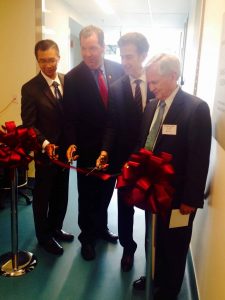
(l-r) Interim Executive Director and Medical Director of the Boston Public Health Commission Dr. Huy Nguyen, MLSC Vice President for Communications and Marketing Angus McQuilken, Chief Scientific Officer at Dana-Farber Barrett Rollins, MD, Dana-Farber President and CEO Edward J. Benz Jr., MD. participate in a ribbon-cutting ceremony to celebrate the official opening of Dana-Farber’s Molecular Cancer Imaging Facility in Boston’s Innovation District.
Boston – The Dana-Farber Cancer Institute and the Massachusetts Life Sciences Center (MLSC) recently celebrated the official opening of Dana-Farber’s Molecular Cancer Imaging Facility in Boston’s Innovation District.
The laboratory focuses on making chemical tracers that “light up” cancer cells and molecular pathways, a technology for research on improving cancer diagnosis and developing precision drugs matched to individual patients.
“The capital investments made by the Massachusetts Life Sciences Center in the research capacity of hospitals and academic institutions across the Commonwealth have been crucial to our growing global leadership in the life sciences,” said Governor Charlie Baker. “We congratulate Dana-Farber on the grand opening of its Molecular Cancer Imaging Facility and look forward to seeing the life-saving treatments and therapies that will come from their state-of-the-art research.”
The Molecular Cancer Imaging Facility (MCIF) includes a cyclotron for making short-lived molecular imaging probes that are tracked by PET scanners. The process is key to evaluating experimental drugs and showing whether they hit vulnerable targets within cancer cells.
“Molecular imaging is a cornerstone of the new era of personalized medicine,” said Dana-Farber president and CEO Edward J. Benz Jr., MD. “Our new facility will provide a comprehensive platform for determining drug efficacy within days, instead of weeks or months, shortening the time it takes for new drugs to reach patients.”
Barrett Rollins, MD, Ph.D., chief scientific officer at Dana-Farber, said, “The MCIF cyclotron — the only one in Massachusetts dedicated entirely to cancer research — will allow our scientists to create the tools needed to identify the precise molecular and genetic abnormalities that drive cancer.”
Construction of the facility at Dana-Farber’s Harbor Campus in South Boston’s Innovation District was made possible through a $10 million grant from the MLSC, a state-funded investment agency that supports life sciences innovation, research, development, and commercialization. The MLSC is charged with implementing the state’s 10-year, $1 billion Life Sciences Initiative.
“This facility will save lives by accelerating Dana-Farber’s groundbreaking work in the development of personalized cancer therapies,” said Angus McQuilken, MLSC vice president for communications and marketing. “The project is a great example of the goals of our capital program, as this new facility will serve as a unique resource that will strengthen Massachusetts’ position as the global leader in life sciences innovation.”
The new 50,000sf facility is adjacent to Dana-Farber’s Lurie Family Imaging Center (LFIC). The construction and initial operation of the facility have created jobs for nearly 60 people.
A GE cyclotron has been installed on the first floor of the facility. A cyclotron whirls beams of charged particles at extremely high speeds in a spiral-shaped machine the size of a small car. The particle beams can be used to bombard atoms of different types to produce radioisotopes that are detected by PET scanners. The new cyclotron will produce isotopes including oxygen-15, carbon-11, nitrogen-13, and fluorine-18. Locating the cyclotron adjacent to the Lurie Family Imaging Center is essential because the probes become unusable in a matter of minutes.
“This new facility will strengthen the Innovation District’s status as a hotbed of innovation in the life sciences, and will allow Boston to continue to lead the way in finding cures and improved, personalized cancer therapies,” said Dr. Huy Nguyen, interim executive director and medical director of the Boston Public Health Commission. “The important research that will come from Dana-Farber will not only benefit the people of Boston, but the global community as well.”
In addition to the space being renovated at the Harbor Campus, the MCIF also occupies 6,000sf of cold chemistry and support space in the Longwood Center, which is adjacent to Dana-Farber’s Longwood campus.










